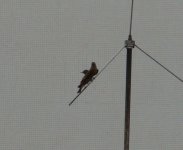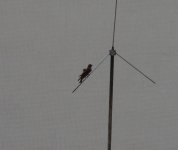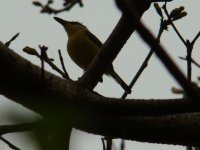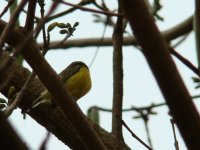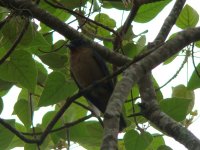jocateme
Well-known member
Hi all,
Here are some pictures taken this weekend of some unsolved mysteries:
1 & 2 - Taken in an urban area (São Paulo city) near a small park. The couple often flew off to catch some insects, making acrobatic movements, and then perched on the same place (this TV antenna). I believe they are Cliff Flycatchers (Hirundinea ferruginea), but wanted confirmation, please.
3 & 4 - Seen in a restaurant near a road in Ourinhos, SP. We stopped there when going to and coming from Londrina. This one was photographed at the frist stop. At the time, I thought it was a Common Tody Flycatcher (Todirostrum cinereum) and, as I had not much time, I forgot to check the lore region, which would avoid confusiton with Yellow-lored Tody Flycatcher (T. poliocephalum). I just considered it a Common then. The problem is that on the second stop, two days later, I have seen and photographed (see here: http://www.birdforum.net/gallery/showphoto.php/photo/158669/limit/recent) a Yellow-lored Tody Flycatcher just in that same restaurant.
5 - Seen in a Arthur Thomas Park in Londrina, Paraná state, S Brazil. It has quite a good Atlantic Forest area (total area of the park, including non-forested area, is 85,47 ha), especially considering its location, very near to the city centre. Anyway, this one was seen outside the highly forested area, just near a lake. No idea what it is.
(6) - No photos of this one. In the top of some trees in the forested area of the same park, I have seen a couple of birds, one green with some yellow and the other blue with a black mask. At the time, I was quite sure they were Swallow Tanagers (Tersina viridis), but after reading in Aves da Grande São Paulo field guide (Develey & Endrigo) that they only occur in SE Brazil (which includes São Paulo, Rio de Janeiro, Minas Gerais and Espírito Santo states) in the first half of the year, I got confused. Although Paraná is located in S Brazil (Paraná, Santa Catarina and Rio Grande do Sul states), Londrina is in N Paraná, very near south-east. Do you think they were Swallow Tanager nonetheless?
Thanks in advance.
Here are some pictures taken this weekend of some unsolved mysteries:
1 & 2 - Taken in an urban area (São Paulo city) near a small park. The couple often flew off to catch some insects, making acrobatic movements, and then perched on the same place (this TV antenna). I believe they are Cliff Flycatchers (Hirundinea ferruginea), but wanted confirmation, please.
3 & 4 - Seen in a restaurant near a road in Ourinhos, SP. We stopped there when going to and coming from Londrina. This one was photographed at the frist stop. At the time, I thought it was a Common Tody Flycatcher (Todirostrum cinereum) and, as I had not much time, I forgot to check the lore region, which would avoid confusiton with Yellow-lored Tody Flycatcher (T. poliocephalum). I just considered it a Common then. The problem is that on the second stop, two days later, I have seen and photographed (see here: http://www.birdforum.net/gallery/showphoto.php/photo/158669/limit/recent) a Yellow-lored Tody Flycatcher just in that same restaurant.
5 - Seen in a Arthur Thomas Park in Londrina, Paraná state, S Brazil. It has quite a good Atlantic Forest area (total area of the park, including non-forested area, is 85,47 ha), especially considering its location, very near to the city centre. Anyway, this one was seen outside the highly forested area, just near a lake. No idea what it is.
(6) - No photos of this one. In the top of some trees in the forested area of the same park, I have seen a couple of birds, one green with some yellow and the other blue with a black mask. At the time, I was quite sure they were Swallow Tanagers (Tersina viridis), but after reading in Aves da Grande São Paulo field guide (Develey & Endrigo) that they only occur in SE Brazil (which includes São Paulo, Rio de Janeiro, Minas Gerais and Espírito Santo states) in the first half of the year, I got confused. Although Paraná is located in S Brazil (Paraná, Santa Catarina and Rio Grande do Sul states), Londrina is in N Paraná, very near south-east. Do you think they were Swallow Tanager nonetheless?
Thanks in advance.
Attachments
Last edited:




